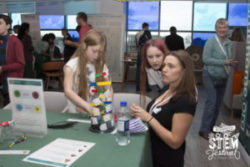Guest post by Sarah Hearne
The ‘leaky pipeline’ is a familiar metaphor to those interested in discussions of women in STEM. The pipeline – the process of going from school to undergraduate level and on into academia until reaching professorship – is seen to leak people, particularly women and minorities, at each successive rung of the academic ladder. Despite its ubiquity, there are growing concerns that the leaky pipeline metaphor is harmful and inaccurate.
A recent paper by David Miller and Jonathan Wai suggests that the pipeline is no longer leaking. The paper examined the percentage of students who go from undergraduate level to PhD level using retrospective analyses of data from US citizens. The data itself seems sound, as do the analyses, but I am concerned about the conclusions drawn. The authors found that while women, in general, used to be awarded PhDs at a lower rate than their male undergraduate counterparts, this is no longer the case: the sexes have converged. This means that male and female undergraduates are equally likely to continue their academic studies. Wonderful news! The pipeline has been fixed!
Well, not so fast. The paper has examined a very particular point in the academic career: the transition from the undergraduate level where a student is really trying to gauge their level of interest in a subject while putting off the whole ‘find a job’ thing for a few years, to the postgraduate level where they feel they may have some real interest and aptitude for their chosen field and would like to pursue it further (and maybe put off that whole ‘find a job’ thing for a few more years!). While obviously it is great to know that women are no longer systematically biased against when it comes to being accepted for PhDs, that step is only one on the long route to becoming a fully fledged academic. And, as the authors point out:
“…the pipeline metaphor may be an apt description of academic transitions after the Ph.D. Academic pathways are considerably more rigid after the Ph.D. degree than before the bachelor’s degree.” [p8]
The paper is cautious and focused in its conclusions, which is as scientific research should be. However, from an online article written by one of the co-authors, you’d be forgiven for thinking that the leaky pipeline metaphor was now dead:
“…new research of which I am the coauthor shows this pervasive leaky pipeline metaphor is wrong for nearly all postsecondary pathways in science and engineering.”
The paper, however, does not say that, and the data doesn’t support such an assertion. It’s bad enough when press officers overhype research due a lack of understanding of the work, but to see an actual author misrepresent their research is extremely disappointing.
So, as much as we might wish it to be true, this paper doesn’t support the idea that the leaky pipeline has been completely sealed. But what about its use as a metaphor? Well, there are two sides to any metaphor: those of accuracy and utility. It appears that despite some areas where cautious optimism may be applied, as shown above, the metaphor is still largely accurate. But is it useful?
The main problem with the metaphor is that it implies that the leak needs to be fixed. Yet the pipeline must leak. In the UK alone there were 98,000 students accepted onto STEM course in 2013. There aren’t enough academic positions for all those students to be employed, and the country would be significantly worse off if all those students decided to work in academia rather than take their skills to other employment sectors where they would make a beneficial contribution.
Specifically in the context of women in STEM, there are concerns that the leaky pipeline metaphor is harming the discussion. That by saying that every woman who leaves academic STEM is a loss, a great deal of internalised pressure is placed on women to pursue careers they are unhappy with and it creates a feeling a failure when they decide to follow a different career path. As Andrew Penner points out, by referring to the leaky pipeline:
“we risk trivializing the contributions of women and men who choose to pursue other endeavors when we define success as becoming a STEM professor at a research university“.
Matthew Cannady and colleagues recently examined the way in which the ‘leaky pipeline’ metaphor fails. They explain that:
“. . . a metaphor positing that those who “leak out,” presumably into a drain, are lost to STEM fails to recognize that there are careers that may not require a STEM bachelor’s degree but do require STEM knowledge and skills and contribute to the public good. The fact that the pipeline metaphor does little to illuminate the paths of mathematics or science educators, or scientifically literate citizens, further challenges its usefulness.” [pp446]
The metaphor, while sadly accurate, appears to be more of a hindrance than a help when trying to discuss and improve women’s representation in academic science. It may be time to find a new metaphor, one that properly appreciates that there are many career choices that allow women, and men, to make use of their scientific training. However, it remains a fact that women are still being excluded from the higher echelons of academia, and whilst that remains true we will all lose out.




